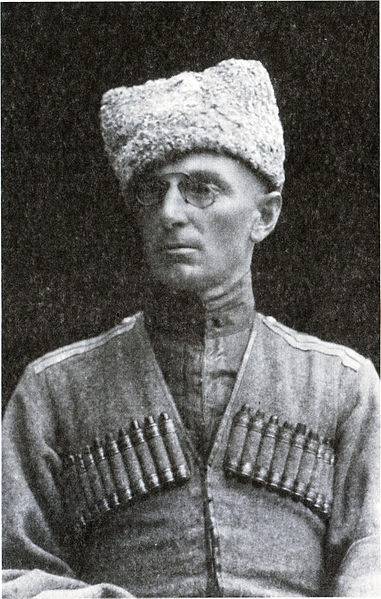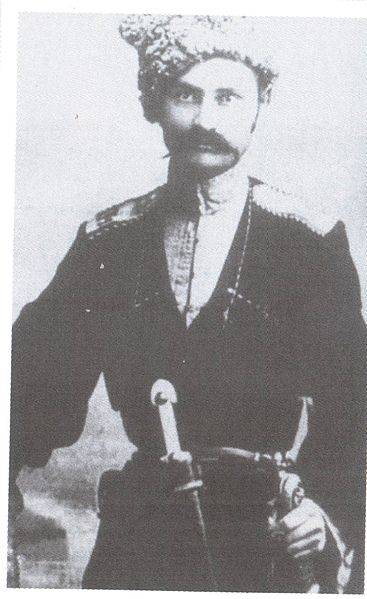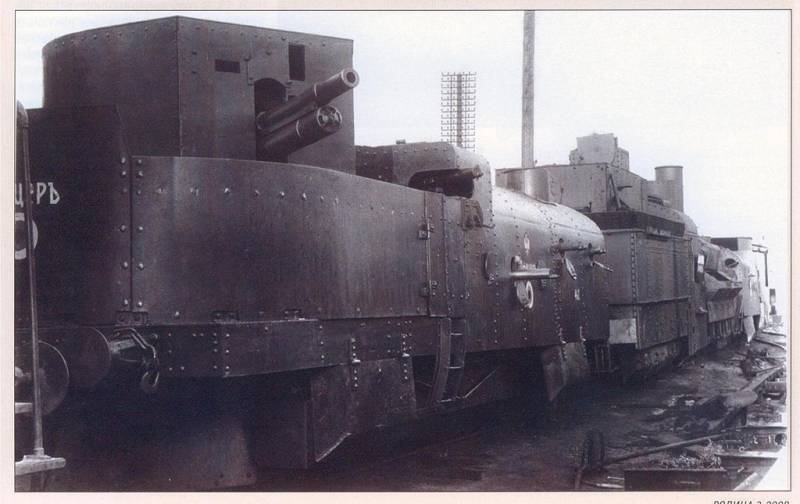Stavropol battle
Battle of Stavropol
October 23 1918, the Taman Reds began an offensive from the Nevinnomysskaya area to Stavropol. The Tamanis were resisted by the remnants of the 2 and 3 divisions of the Volunteer Army (only about 800 bayonets and sabers). The city itself was defended by the Drozdovsky 3 Division and the Plastun Brigade. 23 - October 26 Drozdovtsy waged heavy battles with the Reds, who pressed the volunteers. On October 26, a Kornilov shock regiment was deployed to help Drozdovsky from Torgovaya to Stavropol. The Kornilov regiment was restored after the previous battles, it consisted of: an officer company named after General Kornilov (250 bayonets), three soldiers' battalions, a dozen and three machine guns, and their own artillery. October 27 regiment joined the battle to stop the advance of the Reds, and the Drozdists counterattacked, trying to regain previously lost positions. However, the volunteer attacks had no success, whites suffered serious losses, and in the afternoon, the 3 Division cleared Stavropol, retreating to the north. The Kornilovs suffered huge losses in this battle - more than 600 people. October 28 Red troops occupied Stavropol.
After the capture of the city, the Reds carried out local operations in the north, without seeking or being able to use their victory. Apparently, this was due to the internal problems of the Red Army in the North Caucasus - with the so-called. "Sorokin's rebellion", opposition to the party and military leadership. The red for three weeks remained without operational command. In the meantime, Denikinians won the Armavir Battle (Battle for Armavir). In early November, 1918, the volunteers defeated the Armavir Red group, which made it possible to concentrate all the main forces of Denikin’s army to assault Stavropol. In addition, the Stavropol group under Borovsky (2-I and 3-I divisions) managed to rest and was partially restored.
4 November 1918, General Borovsky, launched an offensive on all fronts. The 2 and 3 divisions under the general command of Borovsky attacked Stavropol from the north on both sides of the railway, the 2 Kuban division from the east through Nadezhda. Volunteers pressed the Reds and even came to the outskirts of the city. On November 5, a stubborn battle continued, and the 2 th Officer Regiment of the Drozdovskiy division seized the monastery of John the Baptist with a swift attack and part of the suburb. Further, however, White could not advance. The Reds were well established in the city and showed strong resistance. On November 6, the Reds repeatedly turned into counterattacks, especially strong on the front of the 3 Division and the Kornilov Regiment. As a result, both sides suffered heavy losses, and the Denikin offensive choked.
At this time, the main forces of Denikin’s army pulled up. General Borovsky in the northern sector went over to active defense; General Wrangell was to attack the city from the west; General Kazanovich - from the south, General Pokrovsky and Shkuro - from the southeast. While there was a concentration of white troops, the Red counterattacked the position of Borovsky. They pushed him, but at the cost of heavy losses, the volunteers maintained their position near the city. At this time, whites consistently surrounded the city.
The leading role in the new assault on Stavropol was played by the Wrangel division. By November 11, the divisions of Wrangel, Kazanovich and Pokrovsky reached the city and established contact with parts of Borovsky. Stavropol was blocked, his communications were cut. The city itself was packed with thousands of wounded, sick and typhoid. Frequent red troops were demoralized. However, the Tamanis, the core of the Stavropol Reds, were ready to fight to the last. November 11 boiled hard all day, the Reds again tried to overturn Borovsky. 2-th division again pushed, she suffered heavy losses. But the reds were also tired and exsanguinated, so on November 12 there was no active fighting. On this day, Denikin's army completed the encirclement of the enemy.
On November 13, taking advantage of the heavy fog, the Red Army men launched a breakthrough of enemy positions in the sectors of the 2 and 3 divisions. In a fierce battle, both sides suffered heavy losses. So, the commander of the Kornilov shock regiment, Colonel Indeykin, was killed; the commander of the Samur regiment, Colonel Schabert, was seriously wounded. Drozdovsky was wounded in the leg. The wounded general was first sent to Yekaterinodar, and then to Rostov-on-Don. However, blood infection began and the surgery did not help. Mikhail Gordeevich Drozdovsky - one of the best and legendary commanders of the White Army, died on 1 (14) on January 1919.

Commander of the 3 Infantry Division M. G. Drozdovsky
On this day, the Tamans were able to break through the front of the enemy. The Reds also attacked parts of Pokrovsky, coming from the southeast, and pressed them. The position of several straightened Wrangel counterattack. As a result, the Reds broke through the encirclement and began to withdraw their rears in the direction of Petrovsky. 14 November fierce fighting continued. Wrangel again proved himself. His cavalry unexpectedly went to the rear in red. Whites broke into the city. The Reds quickly recovered and counterattacked, and in the evening drove the enemy out of the city. On the morning of November 15, after receiving reinforcements, Wrangel went on the offensive again; by the 12 watch, the volunteers took Stavropol. Captured to 12 thousand. Red Army. The fighting in the Stavropol region continued for several more days. As a result, the Reds pushed aside to Petrovsky, where they entrenched themselves. After that, the front stabilized for some time, as both sides suffered great losses and it took time to restore the combat capability of the units. Denikin wrote: "The infantry has ceased to exist."
After the end of the Stavropol battle, Denikin reorganized his troops: the divisions were deployed in the corps. The divisions of Kazanovich and Borovsky were deployed in the 1 and 2 army corps, the 3 army corps was formed under the command of Lieutenant General Lyakhov, and the 1 cavalry division and 2 of the Kuban division formed the 1 corps of Wrangel . The command of the 1 Infantry Division, which was part of the 1 Corps, took Lieutenant-General Stankevich. The command of the "Drozdov" 3 Infantry Division, which also became part of the 1 Corps, was temporarily accepted by Major General May-Mayevsky.
The fate of the entire Volunteer Army depended on the battle for Armavir and Stavropol. Therefore, Denikin pulled here almost all his strength. The fate of the battle hung literally by a thread, but luck again smiled white. The fact was that the Reds themselves helped the White, having started, though necessary, but also the reorganization of the Red Army that happened at the wrong time. Internal divisions in the enemy’s camp helped Denikin’s troops take up and occupy a large region, receiving a logistical base to prepare for an offensive against Moscow.
Armored train of the White "Officer". 7 was formed on August 1918 of the year after the Ekaterinodar was captured by the Volunteer Army. Took part in the storming of Armavir and Stavropol
"Sorokin mutiny"
The fate of the Second Kuban campaign and the entire Volunteer Army depended on the battle for Armavir and Stavropol. Therefore, Denikin pulled into the area of a decisive battle almost all of the available forces. Whites were able to concentrate their forces, and luck smiled at them. Reds had the opposite. The fact was that the Reds themselves helped the whites, they were killed by internal conflicts.
After the reorganization of the North Caucasian Army, which received the serial number 11, the sole power of the commander was abolished and the Revolutionary Military Council (PBC) was put at the head of the army. At the same time, the strife between the party and military leadership (both control centers were located in Pyatigorsk) remained. The Central Election Commission of the North Caucasian Republic and the regional committee of the party tried to establish complete control over the army: to strengthen revolutionary discipline, suppress anarchy and partisanism, to shorten the commander Ivan Sorokin himself. In turn, the commander was dissatisfied with the local Soviet and party elite, and demanded freedom of action for the troops. At the same time, the popularity of the commander in the army declined - the Reds suffered defeats. He had a competitor - the commander of the Taman army, Ivan Matveyev. Under his command, the famous Taman campaign was carried out.
Sorokin, obviously, was on the verge of a nervous breakdown, saw the circle of "provocateurs" and tried with all his might to restore the combat capability of the army. Therefore, a new conflict led to an explosion. The RVS, at the suggestion of Sorokin, decided first of all to smash the enemy in the Stavropol region, to consolidate its position in the eastern part of the North Caucasus, keeping in touch with the center of the country through the Holy Cross to Astrakhan. For this it was necessary to transfer the Taman army from Armavir to Nevinnomysskaya, to withdraw the remaining troops to a new line of defense. Matveyev at a meeting of red commanders in Armavir, with general approval, refused to comply with this order and declared that he was withdrawing from submission to Sorokin. By order of the RVS, Matveyev was summoned to Pyatigorsk and October 11 was shot. This caused great indignation in the ranks of the Tamans, and almost led to rebellion. At the same time, the Tamans believed that this penalty was a personal initiative of Sorokin, who allegedly envied Matveyev’s fame. As a result, the Taman army was reformed and created on its basis two Taman infantry divisions.
At the same time, another conflict occurred in the military-political leadership of the Reds. The party leadership intrigued against Sorokin, believed that the commander wanted to become a military dictator, the "red Napoleon." He decided to eliminate. However, he apparently learned about the plot and delivered a preemptive strike. October 21 1918 of the republic’s leadership - Chairman of the Central Electoral Committee Rubin, secretary of the regional committee Extreme, authorized by the Central Election Commission for Food Dunayevsky, chairman of the front Cheka Rozhansky - was arrested and shot. Party leaders allegedly prepared a conspiracy against the Soviet government and were associated with Denikin.
However, the actions of Sorokin were not supported. The 27 th Extraordinary Congress of the Soviets of the North Caucasus, assembled on October 2, in connection with the statement of Sorokin against the Soviet power, dismissed him from the post of commander. Sorokin was declared "outlawed, as a traitor and traitor to Soviet power and revolution." The commander tried to find support in the army and left Pyatigorsk in the direction of Stavropol. October 30 Sorokin with his headquarters was arrested by cavalrymen of the Taman army. The Tamanis, disarming the headquarters and the personal convoy of Sorokin, concluded them together with the former commander-in-chief in a Stavropol prison. On November 1, the commander of the 3 th Taman regiment of Vyshlenko shot the former commander Sorokin.
So one of the most courageous, enterprising and talented red commanders perished. With a better set of circumstances, Sorokin could easily have entered the cohort of the best Red commanders. Sorokin had to fight right on the "three fronts" - against the whites, the local party leadership and the Tamans. In the end, he lost. Already after the defeat of the Red Army in the North Caucasus, Sorokin became the scapegoat, all sins and mistakes of the local military and political leadership were written off to him. He was declared a "traitor" and an "adventurer." It is clear that Sorokin showed "adventurism" - a personal initiative, which was typical of many commanders of the Civil War (both red and white), but he was not a traitor. "Sorokinschinoy" explained all the defeats 11 th Red Army.
Thus, the unrest in the red camp helped the white people take up in the region. The elimination of Sorokin did not strengthen the combat capability of the army, on the contrary, the commander was popular among the troops and his death only increased the confusion. The leadership did not even know how many troops were in the Red Army in the North Caucasus. When Stalin (a member of the RVS of the Southern Front, which included the 11-I army) asked the party leadership about the number of red troops in the North Caucasus, he received different figures: from 100 to 200 thousand people. Stalin replied: “What are you leaders? You do not know how many troops you have. ” But the new commander, Fedko, could not change anything, after replacing him in December, military officer Kruse, after some time, went over to the side of the enemy. The Red Army in the North Caucasus was demoralized, the soldiers deserted by the hundreds, went over to the side of the enemy.
Another reason for the defeat of the Reds in the North Caucasus was the terrible epidemic of typhoid. As noted by the chairman of the PBC 11 Army J. Poluyan army thawed, not even by day, but by the hour. At the beginning of January, 1919, about a thousand people were received daily in hospitals and hospitals. Among other reasons for the defeat of the 11 Army were noted: material problems - lack of ammunition, uniforms, etc., with the onset of cold weather began mass desertion; lack of experienced team and political leadership; lack of interaction with the 12 army and full communication with the center of the country; low morale, military and political training of local Stavropol peasants, who whole regiments went over to the side of the enemy.

The commander of the Red Army in the North Caucasus, Ivan Lukich Sorokin
Results
In the Armavir and Stavropol battles, the Volunteers were able to break the strength of the Red Army in the North Caucasus. At the same time, the battles for Stavropol really were unusually stubborn, the best parts of the Volunteer Army suffered heavy losses, the color of the White Guards was knocked out. During the trip, some volunteer units changed their composition several times. Denikin, who had to fill in the units, had to abandon the voluntary principle, and forced mobilization began. First, the Kuban Cossacks began to be called into the army, and since August this principle has been extended to other segments of the population. Thus, mobilization of the non-Kazak population in the Kuban and the peasants of the Stavropol province was made. They called upon the numerous officers of the region, which had previously taken a neutral position. Also, the troops replenished at the expense of prisoners of the Red Army. As a result, the composition of the army has changed radically. This did not have the best effect on the fighting and morale of the White Army.
The second Kuban campaign was completed. Denikin's army captured the Kuban, part of the Black Sea coast, most of the Stavropol province. However, Denikin did not have the strength to finish off the Reds. Therefore, the Reds, recovering and increasing the number of their army to 70 - 80 thousand people, in December 1918 - January 1919, even tried to counterattack. Fighting for the North Caucasus continued until February 1919. Only after this, Denikin’s army received a relatively calm rear and strategic base in the North Caucasus for the subsequent march on Moscow.

Information